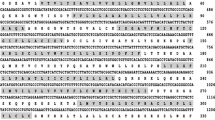Abstract
A cDNA of Japanese flounder (Paralichthys olivaceus) CC chemokine designated as Paol-SCYA104 was cloned and sequenced. The cDNA contains an opening reading frame of 315 nucleotides encoding 104 amino acid residues. The full gene was cloned and sequenced from a BAC library. It has a length of approximately 750 bp from the start codon to the stop codon and is composed of four exons and three introns. Four cysteine residues are conserved in the same positions as those of mammalian and fish CC chemokines. Paol-SCYA104 gene was expressed in several organs, including peripheral blood leukocytes (PBLs), head kidney, trunk kidney, and spleen. The recombinant Paol-SCYA104 was expressed in Escherichia coli and the expressed protein was partially purified. The recombinant Paol-SCYA104 was able to attract Japanese flounder PBLs in a microchemotaxis chamber. On the other hand, a negative control, the fraction of the control cells carrying an expression vector lacking the Paol-SCYA104 cDNA, did not show chemotactic activity. These results indicate that Paol-SCYA104 probably acts as a CC chemokine.







Similar content being viewed by others
References
Baggiolini M (1998) Chemokines and leukocyte traffic. Nature 392:565–568
Dixon B, Shum B, Adams AJ, Magor KE, Hedrick RO, Muir DG, Parham P (1998) CK-1, a putative chemokine of rainbow trout (Oncorhynchus mykiss). Immunol Rev 166:341–348
Edgerton MD, Gerlach L, Boeson TP, Allet B (2000) Expression of chemokines in Escherichia coli. Methods Mol Biol 138:33–40
Fernandez EJ, Lolis L (2002) Structure, function, and inhibition of chemokines. Annu Rev Pharmacol Toxicol 42:469–499
Fujiki K, Shin DH, Nakao M, Yano T (1999) Molecular cloning of carp (Cyprinus carpio) CC chemokine, CXC chemokine receptors, allograft inflammatory factor-1, and natural killer cell enhancing factor by use of suppression subtractive hybridization. Immunogenetics 49:909–914
Hall TA (1999) BioEdit: a user-friendly biological sequence alignment editor and analysis program for Windows 95/98/NT. Nucleic Acids Symp Ser 41:95–98
Hirono I, Nam BH, Kurobe T, Aoki T (2000) Molecular cloning, characterization, and expression of TNF cDNA and gene from Japanese flounder Paralichthys olivaceus. J Immunol 165:4423–4427
Huising MO, Stet RJM, Kruiswijk CP, Savelkoul HFJ, Lidy Verburg-van Kemenade BM (2003a) Molecular evolution of CXC chemokines: extant CXC chemokines originate from the CNS. Trends Immunol 24:306–312
Huising MO, Stolte E, Flik G, Savelkoul HFJ, Verburg-van Kemenade BM (2003b) CXC chemokines and leukocyte chemotaxis in common carp (Cyprinus carpio L.). Dev Comp Immunol 27:875–888
Katagiri T, Hirono I, Aoki T (1997) Identification of a cDNA for medaka cytoskeleton β-actin and construction for the reverse transcriptase-polymerase chain reaction (RT-PCR) primers. Fish Sci 63:73–76
Katagiri T, Asakawa S, Hirono I, Aoki T, Shimuzu N (2000) Genomic BAC library of Japanese flounder Paralichthys olivaceus. Mar Biotechnol 2:571–576
Khattiya R, Hirono I, Aoki T (2003) Molecular cloning, gene structure and expression of two CC chemokines from Japanese flounder Paralichthys olivaceus. Fish Sci 69:1063–1072
Kuroda N, Uinuk-ool TS, Sato A, Samonte IE, Figueroa F, Mayer WE, Klein J (2003) Identification of chemokines and a chemokine receptor in cichlid fish, shark, and lamprey. Immunogenetics 54:884–895
Lally J, Al-Anout F, Bols N, Dixon B (2003) The functional characterization of CK-1, a putative CC chemokine from rainbow trout (Oncorhynchus mykiss). Fish Shellfish Immunol 15:411–424
Liu L, Fujiki K, Dixon B, Sundick RS (2002) Cloning of a novel rainbow trout (Oncorhynchus mykiss) CC chemokine with a fractalkine-like stalk and a TNF decoy receptor using cDNA fragments containing AU-rich elements. Cytokine 17:71–81
Mackay CR (2001) Chemokines: Immunology’s high impact factors. Nat Immunol 2:95–101
Mount DW (2001) Bioinformatics: sequence and genome analysis. Cold Spring Harbor Laboratory Press, Cold Spring Harbor, N.Y.
Murdoch C, Finn A (2000) Chemokine receptors and their role in inflammation and infectious diseases. Blood 95:3032–3043
Nam BH, Hirono I, Aoki T (2003) Bulk isolation of immune response-related genes by expressed sequenced tags of Japanese flounder Paralichthys olivaceus leucocytes stimulated with Con A/PMA. Fish Shellfish Immunol 14:467–476
Nibbs RJB, Salcedo TW, Campbell JDM, Yao XT, Li Y, Nardelli B, Olsen HS, Morris TS, Proudfoot AEI, Patel VP, Graham GJ (2000) C-C Chemokine receptor 3 antagonism by the β-chemokine macrophage inflammatory protein 4, a property strongly enhanced by an amino-terminal alanine-methionine swap. J Immunol 164:1488–1497
Nielsen H, Engelbrecht J, Brunak S, Heijne G (1997) Identification of prokaryotic and eukaryotic signal peptides and prediction of their cleavage sites. Protein Eng 10:1–6
Proudfoot AE, Fritchley S, Borlat F, Shaw JP, Vilbois F, Zwahlen C, Trkola A, Marchant D, Clapham PR, Wells TN (2001) The BBXB motif of RANTES is the principal site for heparin binding and controls receptor selectivity. J Biol Chem 276:10620–10626
Rollins BJ (1997) Chemokines. Blood 90:909–928
Saitou N, Nei M (1987) The neighbor-joining method: a new method for reconstructing phylogenetic trees. Mol Biol Evol 4:406–425
Taub DD (2000) Modified microchemotaxis assays. In: Proundfoot AEI, Wells TNC, Power CA (eds) Chemokine protocols. Humana, Totowa, N.J., pp 105–112
Thompson JD, Gibson TJ, Plewniak F, Jeanmougin F, Higgins DG (1997) The Clustal X windows interface: flexible strategies for multiple sequence alignment aided by quality analysis tools. Nucleic Acids Res 24:4876–4882
Van Damme J, Conings R (1995) Assays for chemotaxis. In: Balkwill PR (ed) Cytokines: a practical approach. Oxford University Press, New York, pp 215–224
Acknowledgments
This research was supported in part by a Grant-in-Aid for Scientific Research (S) (15108003) from the Ministry of Education, Culture, Sports, Science, and Technology of Japan.
Author information
Authors and Affiliations
Corresponding author
Rights and permissions
About this article
Cite this article
Khattiya, R., Ohira, T., Hirono, I. et al. Identification of a novel Japanese flounder (Paralichthys olivaceus) CC chemokine gene and an analysis of its function. Immunogenetics 55, 763–769 (2004). https://doi.org/10.1007/s00251-003-0638-x
Received:
Revised:
Published:
Issue Date:
DOI: https://doi.org/10.1007/s00251-003-0638-x




